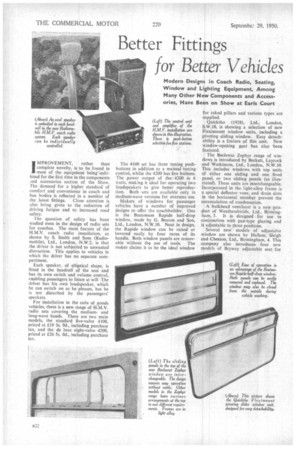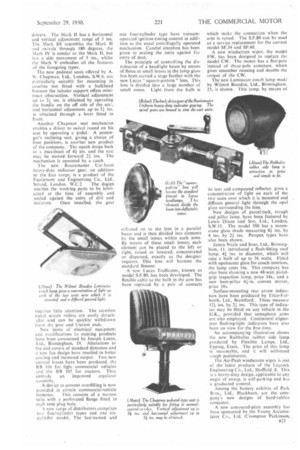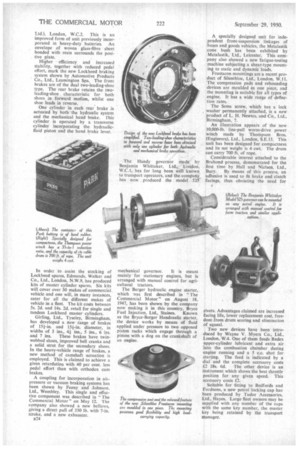Better Fittings for Better Vehicles
Page 56

Page 57

Page 58

If you've noticed an error in this article please click here to report it so we can fix it.
Modern Designs in Coach Radio, Seating, Window and Lighting Equipment, Among Many Other New Components and Accessories, Have Been on Show at Earls Court IMPROVEMENT, rather than complete novelty, is to be found in most of the equipment being exhibited for the first time in the components and accessories section of the Show. The demand for a higher standard of comfort and convenience in coach and bus bodies is reflected in a number of
the latest fittings. Close attention is also being given to the reduction of driving fatigue and to increased road safety.
The question of safety has been studied even in the design of radio sets for coaches. The main feature of the H.M.V. coach radio installation, as shown by S. Smith and Sons (Radiomobile), Ltd., London, N.W.2, is that the driver is not subjected to unwanted distraction. This applies to vehicles in which the driver has no separate compartment.
Each speaker, of elliptical shape, is fitted in the headroll of the seat and has its own switch and volume control, enabling passengers to listen at will The driver has his own loudspeaker, which he can switch on as he pleases, but he is not disturbed by the passengers' speakers.
For installation in the cabs of goods vehicles, there is a new range of H.M.V. radio sets covering the mediumand long-wave bands. There are two main models, the standard five-valve 4100, priced at £19 3s. 9d., including purchase tax, and the de luxe eight-valve 4200, priced at £26 5s. Od.. including purchase tax. The 4100 set has three tuning pushbuttons in addition to a manual tuning control, whilst the 4200 has five buttons. The power output of the 4200 is 6 watts, making it ideal for operating two loudspeakers to give better reproduction. Both sets are available only in medium-wave versions for overseas use.
Makers of windows for passenger vehicles have a number of improved designs to offer the coachbuilder. One is the Beatonson Rapide half-drop window, made by G. Beaton and Son, Ltd., London, N.W.10. Neat in design, the Rapide window can be raised or lowered easily by four turns of its handle. Both window panels are removable without the use of tools. The maker claims it to be the ideal window for raked pillars and various types are supplied.
Quicktho (1928), Ltd., London, S.W.I8, is showing a selection of new Fleximount window units, including a pivoting sliding window. Easy detachability is a feature of this unit. New window-opening gear has also been featured.
The Beclawat Zephyr range of windows is introduced by Beckett, Laycock and Watkinson, Ltd., London, N.W.10. This includes windows with top units of either one sliding and one fixed panel, or two sliding panels (as illustrated). These units are interchangeable. Incorporated in the light-alloy frame is a special deflector vane, and drain slots in the horizontal member prevent the accumulation of condensation.
A bulkhead ventilator is a new product of Weathershields, Ltd., Birmingham, 5. It is designed for use in conjunction with pan-type glazing and is adjustable to three positions.
Several new models of adjustable window are shown by Hallam, Sleigh and Cheston, Ltd., Birmingham, 4. This company also introduces four new models of Bryway adjustable seat for
drivers. The Mark 11 has a horizontal and vertical adjustment range of 3 ins. The Mark Ill resembles the Mark It and swivels through 180 degrees, the Mark IV is similar to the Mark 11, but has a side movement of 5 inswhilst the Mark V embodies all the features of the foregoing types.
The new pedestal seats offered by A. M. Chapman, Ltd., London, S.W.6. are particularly suitable for mounting in coaches not fitted with a bulkhead because the tubular support offers minimum obstruction. Vertical adjustment up to 31 ins, is obtained by operating the handle on the off side of the seat, and horizontal adjustment up to 31 ins. is obtained through a lever fitted in front.
Another Chapman seat mechanism enables a driver to swivel round on his seat by operating a pedal.. A passenger's reclining seat, giving a choice of four positions, is another new product of the company. • The squab drops back to a maximum of 41 ins, and the seat may be moved forward 21 ins. The mechanism is operated by a catch.
The new Routemaster Uni-form heavy-duty indicator gear, an addition to the Eco range, is a product of the Equipment and Engineering Co.. Ltd., Strand, London. W.C.2 The deign enables the working parts to be lubricated at the time of assembly and sealed against the entry of dirt and moisture. Once installed, the gear requres little attention. The seamless meal screen rollers are easily detachable and can be quickly. withdrawn from the gear and friction ends.
New items or electrical equipment and modifications to existing products have been announced by Joseph Lucas, 1.td., Birmingham, 19. Alterations to the end covers of standard dynamos and a new fan design have resulted in better cooling and increased output. Two new control boxes have been produced. the RB 106 for light commercial vehicles ard the RB 107 for tractors. They embody an improved regulator assembly.
A dev:ce to prevent overfilling is now provided in certain commercial-vehicle batteries. This consists of a narrow tube with a perforated flange fitted in each vent plug hole.
A new range of distributors comprises two four-cylinder types and one sixcylinder model. The last-named and one four-cylinder type have vaCuumopera ted ignition-timing control in addition to the usual centrifugally operated mechanism. Careful attention has been given to sealing the units against the entry of dust.
The principle of controlling the distribution of a headlight beam by means of flutes or small lenses in the lamp glass has been carried a stage further with the new Lucas " square-pattern " lens. This lens is divided into a large number of small zones. Light from the bulb is reflected on to the lens in a parallel beam and is then divided into elements by the small lenses within each zone. By means of these small lenses, each clement can be placed to the left or right, raised or lowered, concentrated or dispersed, exactly as the designer requires. This lens will become the standard fitment.
A new Lucas Trafficater, known as model S.F.80, has been developed. The flexible cable to the bulb in the. arm has been replaced by a pair of contacts which make the connection when the arm is raised, The S.F.80 can be used as a service replacement for the current model SF.34 and SF.40.
A new windscreen wiper, the model FW, has been designed to replace the model CW. The motor has a five-pole instead of three-pole armature, which gives smoother running and double the torque of the CW.
The new Luminator coach lamp made by Wilmot Breeden, Ltd„ Birmingham. 25, is shown. This lamp, by means of its lens and compound reflector, gives a concentration of light on each of the two seats over which it is mounted and . diffuses general light through the opal glass surrounding the lens.
New designs of parcel-rack, trough and pillar lamp, have been featured by Lewis Dixon and Son, Ltd., London, S.W.15. The model 500 has a moonstone glass shade measuring 81 ins. by 4 ins. by 2+ ins. Perspex types have also been shown.
James Neale and Sons, Ltd., Birmingham, 11, introduced a flush-fitting roof lamp, 4.2 ins, in diameter, which will Lake a bulb of up to 36 watts. Fitted with opalescent glass for coach interiors, the lamp costs 16s. This company has also been showing a new 48-watt pistolgrip inspection lamp, price 14s., and a new bent-pillar 41-in. convex mirror, price 16s.
Surface-mounting rear arrow indicators have been produced by Trico-Folberth, Ltd., Brentford. These measure 121 ins. by 21 ins. This type of indicator may be fitted on any vehicle in the U.K.. provided that semaphore arms are also employed. Continental clignoteur flashing-light indicators have also been on view for the first time.
An accompanying illustration shows the new Rubbolite rubber side lamp produced by Flexible Lamps, Ltd., Epping, Essex. The price of this lamp is reasonable, and it will withstand rough punishment.
Thc Air-Push windscreen wiper is one of the latest products of the Laycock Engineering Co., Ltd., Sheffield, 8. This is a heavy-duty design, applicable to any angle of sweep, is self-parking and his a graduated control.
Among the battery exhibits of Park Bros.. Ltd.. Blackburn, are the company's new designs of hard-rubber container.
A new armoured-plate assembly has been sponsored by the Yonne Accumulator Co., Ltd. (Crompton Parkinson. , Ltd.), London, W.C.2. This is an improved form of unit previously incorporated in heavy-duty batteries. An envelope of woven glass-fibre sheet bonded with resin surrounds the positive plate.
Higher efficiency and increased stability, together -with reduced pedal effort, mark the new Lockheed braking system shown by Automotive Products Co., Ltd., Leamington Spa. The front brakes are of the dual two-leading-shoe type. The rear brake retains the twoleading-shoe characteristic for both shoes in forward motion, whilst one shoe leads in reverse.
One cylinder in each rear brake is actuated by both' the hydraulic system and the mechanical hand brake. This cylinder is operated by a transverse cylinder incorporating the hydraulicfluid piston and the hand brake lever.
In order to assist the stocking of Lockheed spares, Edmunds. Walker and Co., Ltd., London, N.W.9, has produced kits of master cylinder spares. Six kits will cover over 30 makes of commercial vehicle and one will, in many instances, cater for all the different makes of vehicle in a fleet. The kit costs between 5s. 2d. and 14s. 2d. retail for single and tandem Lockheed master cylinders.
Girling, Ltd., Tyseley, Birmingham, has developed a new range of brakes of 15i-in. and 15i-in, diameter, in widths of 3 ins., 44 ins., 5 ins., 6 ins. and 7 ins. These brakes have twinwebbed shoes, improved bell cranks and a solid strut for the secondary shoes. In the heavy-vehicle range of brakes, a new method of camshaft actuation is employed. This is claimed to achieve a given retardation with 40 per cent, less pedal effort than with orthodox cam
• brakes.
A coupling for incorporation in airpressure or vacuum braking systems has been shown by Feeny and Johnson. Ltd., Wembley. This single and effective component was described in "The Commercial Motor" on May 12. The company also showed a new bellows, giving a direct pull of 330 lb. with 7-in. stroke, and a new exhauster.
B24 The Handy governor made by Benjamin Whittaker, Ltd., London, W.C.1, has for long been well known to transport operators, and the company has now produced the model 525 mechanical governor. It is meant mainly for stationary engines, but is arranged with manual control for agricultural tractors.
The Berger hydraulic engine starter, which was first described in "The Commercial Motor" on August 18, 1947, has been shown by the company now making it in this country, Bryce Fuel Injection. Ltd., Staines. Known as the Bryce-Berger Handraulic starter, the device works by means of fluid applied under pressure to two opposed piston racks which engage through a pinion with a dog on the crankshaft of an engine. A specially designed unit for independent front-suspension linkages of buses and goods vehicles, the Metalastik cone bush has been exhibited by Metalastik, Ltd., Leicester. This company also showed a new fatigue-testing machine subjecting a shear-type mounting to static and dynamic loads.
Frustacon mountings are a recent product of Silentbloc, Ltd., London. W.11. The compression pads and rebounding devices are moulded in one piece, and the mounting is suitable for all types of engine. It has a wide range of deflection rates.
The Sems screw, which has a lock washer permanently attached, is a new product of L. H. Newtor, and Co.. Ltd., Birmingham, 7.
An illustration appears of the new 10,000-113. line-pull worm-drive power winch made by Thompson Bros. (Engineers), Ltd., London, S.E.13. This unit has been designed for compactness and its net weight is 4 cwt. The drum can carry 700 ft. of rope.
Considerable interest attached to the Brabond process, demonstrated for the first time by Hall and Nielsen, Ltd., Bury. By means of this process, an adhesive is used to fit brake and clutch facings, thus obviating the need for rivets. Advantages claimed are increased facing life, lower replacement cost, freedom from drum scoring and elimination of squeal.
Two new devices have been introduced by Wayne V. Myers Co., Ltd.. London, W.4. One of them feeds Redex upper-cylinder lubricant and extra air Into the combustion chamber duning engine running and a 5 c.c. shot for starting. The feed is indicated by a dial and the complete accessory costs
£2 18s. 6d. The other device is an instrument which shows the best throttle position for any given speed. This accessory costs £2.
Suitable for fitting to Bedfords and Fordsons, a new petrol locking cap has been produced by Tudor Accessories, Ltd., Hayes. Large fleet owners may be supplied with any number of the caps with the same key number, the master key being retained by the transport manager.




























































































